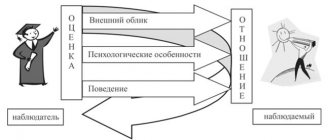The sides of communication are closely interconnected. In total, there are three aspect aspects of the communication interaction of individuals, namely communicative, perceptual and interactive. The boundaries between such sides of communication are quite symbolic and often merge, complementing each other. The aspects of communication in psychology should be considered from the perspective of joint activity and as a special activity. Communication interaction is a unique structural model containing two aspects: content and formal. The substantive aspect of interaction is reflected in the communicative function of communication, and the formal aspect in the behavioral side of communication, which is realized during the interaction.
Three aspects of communication
The sides of the communication process are closely interconnected.
Often the boundaries between them are quite symbolic and one side can merge with the other, complementing it.
In psychology, there are three key aspects of communication:
- communicative _ There is a direct exchange of information between the participants in the interaction. The main way of communication is speech. With the help of speech, people share judgments and points of view, discuss problems, resolve issues;
- perceptual _ At the cognitive level, the process of people perceiving each other occurs. During a conversation, a judgment is formed about the interlocutor, which is based on consideration of his appearance, facial expressions, voice gestures, and actions;
- interactive _ Direct formation of joint activities of subjects. The relationship between the parties to the interaction is determined on the basis of the actions and actions that they perform at a given stage of time.
Are you an expert in this subject area?
We invite you to become the author of the Directory. Working conditions. Each side has a number of features.
Structure of communication in psychology
When communicating, the social relationship of people to each other is realized. During the exchange of information, each person is rooted as a full member of society. The concept of “communication” is a complex form of interaction, therefore, in order to understand its essence, it is necessary to study its components:
- communication;
- interaction;
- social perception.
The diagram shows that each part is responsible for one of the sides of communication.
Scheme
The communicative side of speech
Definition 1
Communication is a type of active interaction between objects of any nature, which involves information exchange.
Communication between people is distinguished by the following specific features:
- Firstly, it undoubtedly must contain two individuals, each of whom is an active subject. At the same time, their mutual information implies the organization of joint activities.
- Secondly, it must contain the possibility of mutual influence of partners on each other through the concept of signs. In other words, the exchange of information in this case implies an influence on the behavior of the interlocutor and a change in the state of the participants in the communication process.
- Thirdly, influence in communication can only be exercised if there is a unified concept of decodification and codification between the communicator (the person who sends information) and the recipient (the person who receives it).
- Fourth, communication barriers are always likely to arise. In this case, the connection that exists between attitude and communication is clearly visible.
Finished works on a similar topic
Coursework Sides of communication in psychology 440 ₽ Essay Sides of communication in psychology 220 ₽ Test work Sides of communication in psychology 230 ₽
Receive completed work or specialist advice on your educational project Find out the cost
The model of the communication process, as a rule, contains five components: communicator - message (text) - channel - audience - feedback.
Definition 2
The communication side is a way of psychologically influencing the interlocutor. During the period of information transfer, one person influences another. The better a subject’s communication skills are developed, the higher the degree of influence he has on his own interlocutors.
Information is provided on two levels:
- Incentive. These are remarks of a pleading, commanding, recommendatory nature. They are expressed with the task of stimulating a person to perform some action.
- Stater. Speech at this level is of a notification nature, which is aimed at providing any information. Ranges from indifferent presentation to active persuasion.
Structure and functions of communication
Communication structure. Communication, as a rule, manifests itself in the unity of its five sides: interpersonal, cognitive, communicative-informative, emotional and behavioral.
The interpersonal side of communication reflects a person’s interaction with his immediate environment: with other people and communities with whom he is connected in his life. First of all, it is the family and professional groups that use the established cultural, historical and professional models of behavior. Along with these behavioral models, a person learns national-ethnic, social-age, emotional-aesthetic and other norms and stereotypes of communication.
The cognitive side of communication allows you to answer questions about who the interlocutor is, what kind of person he is, what to expect from him and many other questions related to the personality of the partner. It includes not only the perception of another, but also self-knowledge. Thus, in the process of communication, figurative ideas about oneself and about the partner are formed, which regulate this process.
The communicative and informational side of communication is an exchange between people with different perceptions, ideas, interests, moods, feelings, attitudes, etc. If all this is considered as information, then the communication process can be understood as a process of information exchange. But this approach to human communication is very simplified.
The emotional side of communication refers to the functioning of emotions, feelings, and moods in personal contact between partners. They manifest themselves in the expressive movements of the subjects of communication, their actions, deeds, and behavior. Through them, relationships are formed, which become a kind of socio-psychological background of interaction and predetermine greater or lesser success of joint activities.
The behavioral side of communication serves to harmonize internal and external contradictions in the positions of partners. It has a controlling influence on the individual in all processes of life, reveals a person’s desire for certain values, expresses the driving forces of a person, and regulates relations between partners in joint activities.
The psychological structure of communication includes four components:
The motive-logical component is a system of motives and goals of communication. The motives for communication between members can be:
- Needs, interests of the person who takes the initiative in communication;
- the needs and interests of both communication partners in order to encourage them to communicate;
- Needs arising from jointly solved problems.
- Psychology of Verbal Communication
Correlation of communication motives from complete agreement to conflict. In accordance with this, communication can be friendly or conflicting in nature.
The main goals of communication can be: obtaining or transmitting useful information, activating partners, reducing tension and guiding joint actions. The goals of communication participants may coincide, contradict or exclude each other. The nature of communication also depends on this.
The communicative component of communication in the narrow sense of the word is the exchange of information between communicating persons. In the course of joint activities, as mentioned above, individuals exchange different opinions, interests, feelings, and so on. All this represents a process of information exchange, which is characterized by the following features:
If in cybernetic devices information is only transmitted, then in human communication it is not only transmitted, but also formulated, clarified, and developed;
Unlike simply “sharing information” between two devices, in human communication it involves relating to each other;
The nature of the exchange of information between people is determined by the fact that partners can influence each other through the symbols of the system, used in this case to influence the behavior of the partner;
Communicative influence through information exchange is possible only if the one who sends the information (communicator) and the one who receives it (recipient) have a common or similar encoding or decoding system. In everyday language this means that people "speak the same language."
The interactive component of communication consists of the exchange of not only knowledge and ideas, but also influences, mutual incentives, and actions. Interaction can take the form of cooperation or competition, agreement or conflict, adaptation or opposition, unification or disunion.
The perceptual component of communication is manifested in the perception of communication partners, mutual study and evaluation of each other. This is due to the perception of a person’s appearance, actions, and actions and their interpretation. Mutual social perception in communication is very subjective, which is not always manifested in a correct understanding of the goals of the communication partner, his motives, attitudes, attitude towards interaction, etc.
Communication functions. Communication performs certain functions. There are six of them:
- the pragmatic function of communication reflects its necessity-motivation and is realized in the interaction of people in the process of joint activity. In this process, communication itself is often the most important need.
- the function of education and development reflects the ability of communication to influence partners, as well as to develop and improve them in all respects. By communicating with other people, a person learns universal experience, historically established social norms, values, knowledge and methods of action, and is formed as a person. In a broad sense, communication can be defined as the universal reality in which human mental processes, states and behavior are born, exist and manifest throughout life.
- the affirmation function allows people to recognize, affirm, and validate themselves.
- the function of association-dissociation of people, on the one hand, by establishing contacts between them, facilitates the transfer of necessary information to each other and sets them up for the implementation of common goals, intentions, tasks, thereby uniting them into a single whole, and on the other hand, can contribute to differentiation and isolation of individuals as a result of communication.
- the function of organizing and maintaining interpersonal relationships serves the interests of establishing and maintaining fairly stable and productive connections, contacts and relationships of people in the interests of their joint activities.
- The intrapersonal function of communication is realized in a person’s communication with himself (through internal or external speech, which is carried out depending on the type of dialogue). This communication can be considered as a universal form of human thought.
The interactive side of communication
When communicating, changes in people's behavior appear. There are many options for shaping the situation. The main types of interaction include:
- cooperation, in which goals are achieved through joint efforts;
- competition (one infringes on the other on the way to achieving the goal);
- confrontation, which is characteristic of the pursuit of opposing objectives in communication;
- corporation with mutual benefit (“you - to me, I - to you”).
To have an impact, the interlocutor often resorts to one of positive or negative practices. A particularly optimal and constructive approach is persuasion, in which the object conveys information with reliable evidence and facts.
Note 1
The interactive side is directly related to the social roles that are characteristic of the subjects of interaction. Society imposes certain obligations on a person that he must fulfill.
Multiple rituals and rules are aimed at regulating the behavior of subjects who intelligently exercise control over their own actions and actions.
The scale of social norms on which the concept of interactive communication operates is quite large.
These include models of behavior determined by the norms of work discipline, military duties, concepts of dignity and honor, and simple rules of upbringing and politeness.
The approved model of behavior in which a person strives to conform depends on his personal traits: age, gender, responsibilities, social status. Thus, a medical worker is expected to show concern and attention, and a waiter is expected to be polite and helpful.
If, during interactive communication with people around him, a person sees approval of his actions, he can judge the coordination of his behavior with the social role he is realizing.
If there is a misunderstanding with members of society, then the individual may conclude that his actions do not meet the expectations that are accepted in this society.










